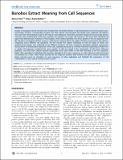Files in this item
Bonobos extract meaning from call sequences
Item metadata
| dc.contributor.author | Clay, Zanna | |
| dc.contributor.author | Zuberbuehler, Klaus | |
| dc.date.accessioned | 2013-11-05T12:01:01Z | |
| dc.date.available | 2013-11-05T12:01:01Z | |
| dc.date.issued | 2011-04-27 | |
| dc.identifier | 17090439 | |
| dc.identifier | cef63095-1b6d-4349-8253-9af6f2966490 | |
| dc.identifier | 000290019400011 | |
| dc.identifier | 79955699567 | |
| dc.identifier.citation | Clay , Z & Zuberbuehler , K 2011 , ' Bonobos extract meaning from call sequences ' , PLoS ONE , vol. 6 , no. 4 , e18786 . https://doi.org/10.1371/journal.pone.0018786 | en |
| dc.identifier.issn | 1932-6203 | |
| dc.identifier.other | ORCID: /0000-0001-8378-088X/work/64360628 | |
| dc.identifier.uri | https://hdl.handle.net/10023/4160 | |
| dc.description | This research was funded by a Leverhulme Trust Research Leadership Award and the Wissenschaftskolleg zu Berlin. The funders had no role in study design, data collection and analysis, decision to publish, or preparation of the manuscript. | en |
| dc.description.abstract | Studies on language-trained bonobos have revealed their remarkable abilities in representational and communication tasks. Surprisingly, however, corresponding research into their natural communication has largely been neglected. We address this issue with a first playback study on the natural vocal behaviour of bonobos. Bonobos produce five acoustically distinct call types when finding food, which they regularly mix together into longer call sequences. We found that individual call types were relatively poor indicators of food quality, while context specificity was much greater at the call sequence level. We therefore investigated whether receivers could extract meaning about the quality of food encountered by the caller by integrating across different call sequences. We first trained four captive individuals to find two types of foods, kiwi (preferred) and apples (less preferred) at two different locations. We then conducted naturalistic playback experiments during which we broadcasted sequences of four calls, originally produced by a familiar individual responding to either kiwi or apples. All sequences contained the same number of calls but varied in the composition of call types. Following playbacks, we found that subjects devoted significantly more search effort to the field indicated by the call sequence. Rather than attending to individual calls, bonobos attended to the entire sequences to make inferences about the food encountered by a caller. These results provide the first empirical evidence that bonobos are able to extract information about external events by attending to vocal sequences of other individuals and highlight the importance of call combinations in their natural communication system. | |
| dc.format.extent | 10 | |
| dc.format.extent | 292549 | |
| dc.language.iso | eng | |
| dc.relation.ispartof | PLoS ONE | en |
| dc.subject | Food associated calls | en |
| dc.subject | White faced capuchins | en |
| dc.subject | Golden lion tamarins | en |
| dc.subject | Cotton-top tamarins | en |
| dc.subject | Alarm calls | en |
| dc.subject | Pan paniscus | en |
| dc.subject | Elicited vocalisations | en |
| dc.subject | Playback experiments | en |
| dc.subject | Cebus capucinus | en |
| dc.subject | Q Science | en |
| dc.subject.lcc | Q | en |
| dc.title | Bonobos extract meaning from call sequences | en |
| dc.type | Journal article | en |
| dc.contributor.institution | University of St Andrews. School of Psychology and Neuroscience | en |
| dc.contributor.institution | University of St Andrews. Institute of Behavioural and Neural Sciences | en |
| dc.contributor.institution | University of St Andrews. Centre for Social Learning & Cognitive Evolution | en |
| dc.identifier.doi | https://doi.org/10.1371/journal.pone.0018786 | |
| dc.description.status | Peer reviewed | en |
This item appears in the following Collection(s)
Items in the St Andrews Research Repository are protected by copyright, with all rights reserved, unless otherwise indicated.

